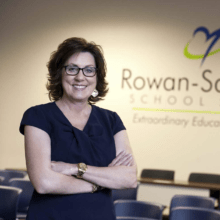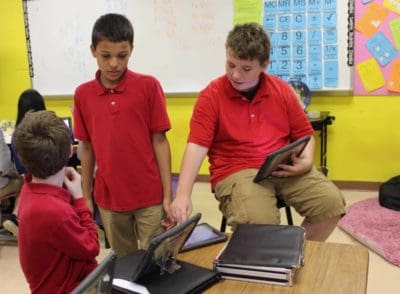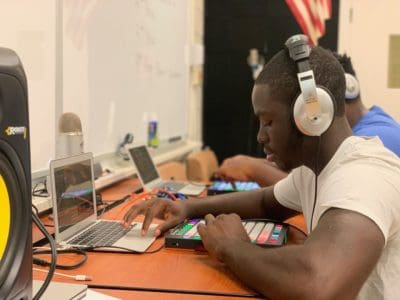The crisis
On Saturday, March 14, 2020 Rowan-Salisbury School System, a 19,500-learner-district in North Carolina where I’m the superintendent, received notice that schools were to be closed for the next two weeks. In our hearts, my leadership team and I knew this crisis would be much longer than two weeks.
The urgency was for this week, and we simultaneously had to think about the medium term. We centered our remote learning conversations around being quick, not perfect, which, as many district leaders will understand, was very difficult for a group of planners and organizers.
Before the COVID-19 crisis
1. Technology: Like many school systems in the last decade, we began our innovation journey in the mid-2010’s with tech.
- Devices: In 2014, our district had adopted 1:1 technology which, all students in grades 3-12, could take home (our K-2s used their 1:1 devices in school only). We chose Apple devices because they allowed our students and staff to work offline and to work creatively. iPads also allowed our students to create videos, projects, and digital products without connectivity. Our entire district, from learners to staff to central office, had over five years practice in thinking, working, learning, and communicating differently.
- The Wi-Fi access gap: Despite iPads’ offline functionality, one of our first digital transformation goals was to close the Wi-Fi access gap. We rallied businesses to offer Wi-Fi hot spots, and, more recently, we partnered with Sprint’s 1 Million Project to provide hot spots for high school students.We worked hard to ensure most of the software we purchased could be used without internet connectivity or at least the ability to download every day.
- Digital device and learning management plan: We also focused on creating as frictionless an experience as possible for our educators, learners, leadership, and staff. JAMF provided us with a mobile device management system that allowed us to remotely push out curriculum and applications to all devices as needed. Canvas provided us with a learning management platform so teachers could communicate with students, and we could provide virtual instruction. We also implemented a variety of digital communication tools such as Class Dojo, Remind, and Canvas that allow us to safely connect with families.
2. Curriculum and assessment: Our first content provider was Discovery Education. Not only did they provide us with streaming educational videos and up-to-date techbooks, but they also provided us with strong professional development. We learned best practices for using content effectively.
We also learned from Discovery Education that it is very important to find partners in this work — not vendors. We wanted to work with companies who genuinely cared about our staff and students. They set the bar for our relationships with future vendors: that we should demand thought partners who support our personal journey. This led us to carefully select others to support our online learning including Achieve 3000, Raz-Kids, Big Universe, Freckle, Edmentum, Mathspace, and Newsela.
3. Professional learning: Since we had Apple devices, we were also able to secure apps to provide specialized instruction. We even created our own iBook for professional development for our teachers. And we began to focus our district conferences on blended learning which helped us to ultimately create our new directional system.
4. Virtual culture: All these steps led us to question if we could do more teaching and working from home. In 2016, we created an inclement weather work-from-home option for staff. Having experienced that, our teachers and staff creating eLearning Days for students in January 2017 within our regular calendar.
Each step thus led to a new discovery. We realized we needed video conferencing to connect our staff and students virtually. In 2017, we began to use Zoom to virtually connect leaders district-wide for important meetings and announcements. Then, we also used it on E-Learning days to connect with students.
Innovation payoff
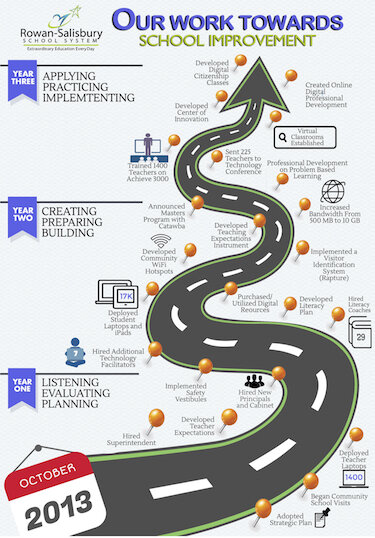
All these steps enabled us to become, in 2018, the first Renewal School System in North Carolina, which gave us curriculum, budget, personnel, and calendar flexibilities for five years. This Renewal legislation allowed us to continue our work reshaping education by removing the current boundaries that limit creative thinking. It created an opportunity for our teachers to “reimagine education” which put them in a position to deliver instruction in non-traditional ways. It helped our teachers to become comfortable with the uncomfortable. It helped us create a mindset shift for change and innovation.
Together, we developed a Directional System that guides all of us towards redesigning learning environments in all 35 of our schools to foster academic skills, interpersonal skills, and unique life purposes in all our students.
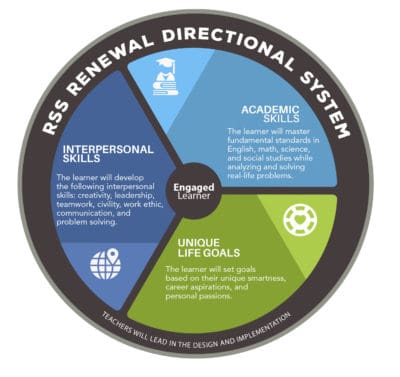
During the COVID-19 crisis
So when Saturday, March 14, 2020 hit, we were as ready as any school district in the country to start teaching remotely. We didn’t even take a break — we just jumped right in. Boy were we in for some surprises when it came to the implementation of daily on-going remote instruction. Here were our issues, in order of appearance, not importance.
1. Exhaustion: Our staff became exhausted quickly. We also discovered our parents were exhausted too. Working from home sounded peaceful, but it caused new levels of stress as parents and teachers struggled with children learning at home while parents continued to work without child care.
2. E-learning days as every day. Teaching every day remotely doesn’t compare to an occasionally e-learning Day. Our epiphany was our practices and pace would have to be different now. We started to learn about the simple importance of learning.
Since 2014 we had talked about true learning and not about subjects or courses, but our beliefs had never been tested so dramatically. To support our educators, we created an employee communication guide with resources about all things COVID-19 and remote learning. The communication is updated and sent to all 3,000 staff members daily.
3. Grading: We had begun conversations, visited some schools, and started reading about competency-based education, but now we would be forced to test those beliefs, too. The relief of standardized testing being waived kept the tail from wagging the dog in every conversation. Now we could finally say to teachers, “Stop worrying about the test, think about what children need.” We were curious, what might emerge?
4. Equity: Inequities show up very quickly. Not all of our children have parents who are willing to co-teach at home with us. And what would we do about the students who were just not responding at all to virtual instruction? How could we provide support to those children who don’t have any support?
These conversations go on all of the time, but what’s different is when we are in school, we can actually see them and we get the chance to try to bridge our learners’ needs every morning. Now we’re having a hard time connecting with them at all. In every one of our schools, there are learners we can’t get a hold of, and others who aren’t responding to the remote learning experience. This is the most troubling disruption. It creates “dropouts” at every grade level.
5. Wellness and trauma: The social and emotional well-being of students is a major concern. Even in the most stable homes, parents and children are worried about their health and safety. Depression and anxiety are setting in for every one, including our teachers. Families are dealing with children with special needs without the regular relief and support our schools provide. And our need to nurture and connect leaves us feeling truly isolated.
Innovation payoff
Our teams started embracing an innovation mindset. Quiet people found their voices. Team members took the lead in feeding children. Dedicated employees dropped their titles at the door and dug into finding solutions.
Our teachers jerry-rigged video-responsive home office set-ups in creative ways. I personally found myself in a space of sincere gratitude; “thank you” has become the most frequently used phrase in my vocabulary. We have all become connected learners.
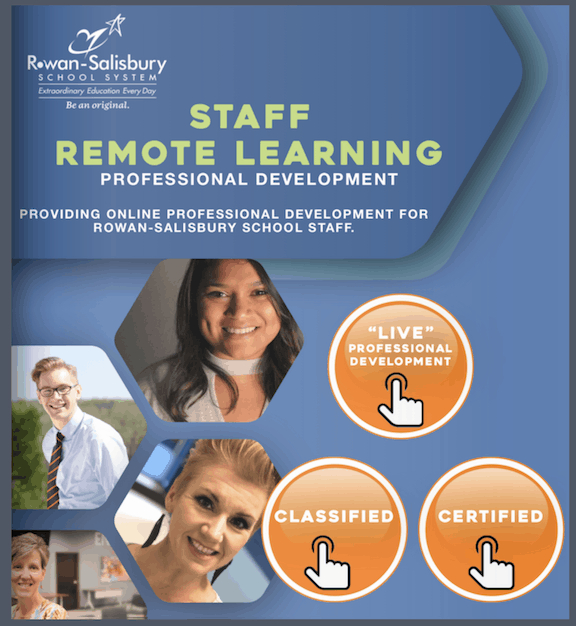
Our PD has skyrocketed. We developed a menu of live and recorded opportunities for our classified and certified staff including 26 different learning modules for our classified staff in two weeks. There have been 1,164 completions thus far.
We built out a detailed Remote Learning Professional Development Guidebook that has had over 9,500 views, and we’ve shared it across the state. We’re getting bolder; we’ve asked renowned educator to host webinars for our much-deserving staff.
After the crisis
As I write this, it is hard to predict the future, but here’s what I hope happens. I hope we live out our new directional system!
- I hope we are able to hone in on the real fundamental standards we need our students to master and eliminate the ones we are finding that are truly not “fundamental.” I hope we discover how to teach those standards through solving real-world problems.
- I hope our entire community — parents, teachers, and mentors — will find ways and times to talk with our students about their unique life goals. I hope we will all use our networks to help our students connect with people who can help them reach those goals.
- I hope we can find ways to talk with our students about their interpersonal skills. I hope we will give them time to reflect and think about how to improve.
- I hope we can give our students the room to invest their passions and time in investigating what they are naturally curious about.
- I hope we encourage our students to read. We will listen to them read aloud, we will talk about what they are reading, and provide them with lots of things that may be interesting to them to read.
- I hope we never make a 9-year-old (or any age) child sit for a three-hour test that has economic biases designed to rank and order children. Rather, I hope we are challenged to discover what is special about all of our children.
- I hope teacher salaries will increase dramatically.
If we don’t take this opportunity to test and try new beliefs, we will have missed a great learning opportunity.
We are experiencing a significant disruption to traditional education. How do we use this to create many of the things we all believe should and could change about education?
I desperately want our children to come back to school! I miss the social interactions and human connections. But I don’t ever plan to work in a district that goes back to one-size-fits-all standardized education system ever again after this experience!
Editor’s note: This perspective was first published by Transcend. It has been posted with the author’s permission.
